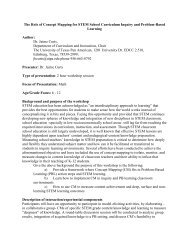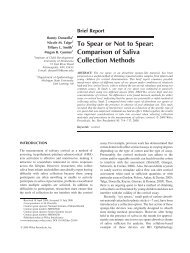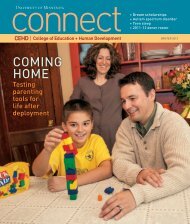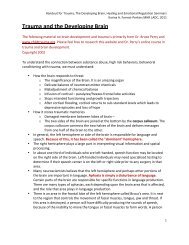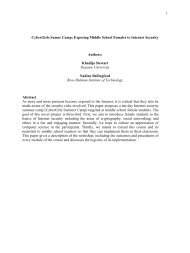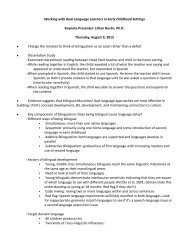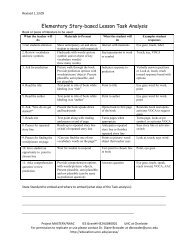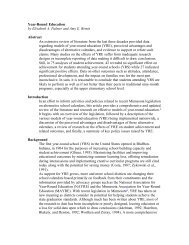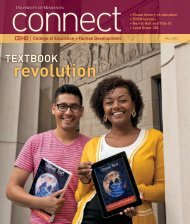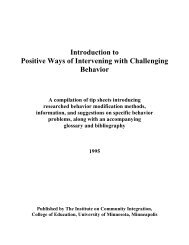connect! - College of Education & Human Development - University ...
connect! - College of Education & Human Development - University ...
connect! - College of Education & Human Development - University ...
You also want an ePaper? Increase the reach of your titles
YUMPU automatically turns print PDFs into web optimized ePapers that Google loves.
Street wisdom<br />
BY BRIGITT MARTIN | WHEN ALUMNUS MATTHEW<br />
AYRES started surveying Minneapolis panhandlers in<br />
February 2007, he hoped to get a clearer picture <strong>of</strong> those who<br />
solicit cash to survive. Little did he know that his work would<br />
help fuel a hotly contested civic argument.<br />
“It’s a livability issue,” says Ayres, who won the Mark S.<br />
Umbreit Scholarship for Restorative Justice and Peacemaking<br />
for 2006–07. “Every year when the good weather starts,<br />
panhandling becomes an issue because people can once again<br />
see the homeless.”<br />
Ayres conducted street interviews with 45 sign-toting<br />
panhandlers—36 men and 9 women—during his final<br />
semester <strong>of</strong> the Master <strong>of</strong> Social Work program, when he<br />
was employed as a part-time intern at the Office to End<br />
Homelessness (OEH). Meanwhile, the Minneapolis City<br />
Council began debating amendments to its already strict<br />
panhandling ordinance.<br />
“Homelessness is what I’m the<br />
most passionate about. I wake<br />
up on Saturday morning thinking<br />
about how we can best help these<br />
people get out <strong>of</strong> shelters and<br />
into safe and stable housing.”<br />
—MATTHEW AYRES<br />
Ayres and Cathy ten Broeke, program coordinator for<br />
OEH, which is jointly funded by the City <strong>of</strong> Minneapolis and<br />
Hennepin County, reacted quickly by tabulating the survey<br />
responses to inform the council members’ discussions.<br />
“We felt that strengthening the ordinance would create an<br />
air <strong>of</strong> hatred and distrust <strong>of</strong> homeless people,” explains Ayres.<br />
The Minneapolis Panhandling Survey is the first<br />
comprehensive survey <strong>of</strong> a panhandling population in a<br />
community in the United States. The subjects ranged in age<br />
from 22 to 76, with an average <strong>of</strong> nearly 6.5 years since their<br />
last permanent housing. Ayres found a clear correlation<br />
between the length <strong>of</strong> time the person had been homeless and<br />
how long they had panhandled—a contrast to arguments that<br />
panhandlers are not homeless but rather are aggressive scam<br />
artists. When asked whether or not they would choose a job<br />
that pays $6.15 per hour over panhandling, 27 <strong>of</strong> those<br />
surveyed answered in the affirmative, while 5 said they are<br />
unable to work.<br />
Ayres feels his research provided some rather surprising<br />
insights. “I guess, like everybody, I assumed that these guys<br />
were hardened by a life on the streets. But many <strong>of</strong> them<br />
became teary when I talked to them, and most <strong>of</strong> them felt<br />
that panhandling was demeaning, demoralizing, and<br />
something that nobody should have to do,” says Ayres.<br />
Ayres and ten Broeke shared their survey results with<br />
council members Ralph Remington, a co-author <strong>of</strong> the<br />
ordinance changes, and with Cam Gordon and Elizabeth<br />
Glidden, both <strong>of</strong> whom voted against the ordinance.<br />
“The changes to the amendment related to verbal<br />
solicitors, not sign carriers, who were the subject <strong>of</strong> Matt’s<br />
survey,” Gordon explains. “However, the survey helped<br />
bolster my case by showing that the ordinance was an<br />
ineffective way to address the homeless population, many <strong>of</strong><br />
whom have psychiatric and substance abuse issues. Outreach<br />
is the best way to help them, and the ordinance was moving<br />
in the opposite direction.”<br />
Though the ordinance passed 9–3, Ayres explains, “Our<br />
success was that the debate changed from being about the<br />
homeless panhandler on the corner to the aggressive guy who<br />
is making people truly uncomfortable.”<br />
Since graduating, Ayres has become a full-time program<br />
analyst at the OEH, and an on-call staff member at Simpson<br />
Men’s Shelter in Minneapolis. At the OEH, Ayres and ten<br />
Broeke are spearheading the implementation <strong>of</strong> a ten-year<br />
plan to end homelessness, called Heading Home Hennepin.<br />
They also organize Project Homeless Connect, a program<br />
designed to link homeless people to the services they need.<br />
“Homelessness is what I’m the most passionate about,”<br />
Ayres proclaims. “I wake up on Saturday morning thinking<br />
about how we can best help these people get out <strong>of</strong> shelters<br />
and into safe and stable housing.”<br />
CEHD.UMN.EDU 27




